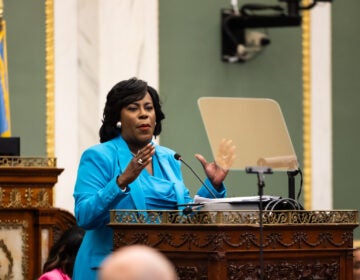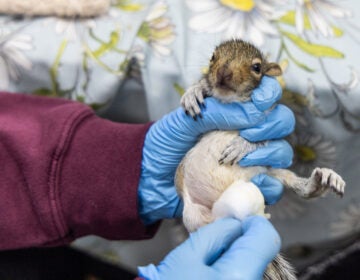Chestnut Hill native looks to revitalize “eroded” American Indian language
Two weeks at a time, Peter Hill fell in love with Pine Ridge, S.D.
As a teen, the Philadelphia native visited the sprawling Lakota reservation during a series of summer work trips organized by St. Martin-in-the-Fields, the Episcopal church his family attended near their home in the city’s Chestnut Hill neighborhood.
Though spread out over five years, the trips had a “strong impact” on Hill’s young mind. So much so, that by the end of his freshman year of college, he knew he wanted to make a life on the reservation after graduation.
Hill, now 34, has lived there ever since.
“It took me a few years to really sort of open my eyes and ears and really learn a lot about what I was seeing,” he said, explaining that his visits raised issues that he had to think about more deeply, “issues of disparities in wealth and issues of cultural hegemony and issues of the history of the country and the history of the people within the borders.”
Comfort through language
To adjust to a culture starkly different from his own, Hill latched onto language.
Though the vast majority of people on the reservation don’t speak Lakota, a dialect of Sioux, the East Coast transplant was driven to learn it, as a way to make inroads with the tight-knit community.
“As someone sort of trying to prove themselves in a new situation, in a small community, as a white person, certainly not the only white person, but bringing with them a lot of that historical baggage, it was very important to me that people saw me as sort of being on the good side.”
Hill worked tirelessly to become fluent. He read, listened and spoke Lakota with anyone he could.The work paid off.
Hill, who now lives in Pine Ridge with his and young daughter, is now known in the community as someone who speaks Lakota well.
His new mission is for others to be viewed the same way.
A new way to bring Lakota back
In the coming weeks, Hill will open a language immersion day-care program on the reservation in hopes of nurturing a new base of fluent Lakota speakers.
“If kids don’t speak it then the language really doesn’t have a future,” said Hill, who taught the language for three years at the high school level. “It becomes an archaism that only exists among the older generation while they’re alive.”
Regularly used 50 years ago, the language has since seen a decline even as Lakota traditions have remained vital.
English is now used for daily interactions with Lakota typically relegated to tribal ceremonies.
“You don’t need to know Lakota to buy groceries or find a place to live or do any of the day-to-day things that you normally would do,” said Hill. “So, there are a lot of people that have lived out here for decades that may only know a couple words of the language.”
Hill hopes to change that with his daycare, the first of its kind.
Other Lakota immersion programs exist in the area, but none of them are geared towards infants and toddlers.
‘The time is now’
Hill’s goal is to begin creating a web of first and second-language speakers.
He hopes students in the immersion program not only will become first language speakers themselves, but will also teach their parents, making them second language speakers.
“It’s the one thing [parents] can’t personally give them, can’t transmit to them,” noted Hill.
Though it hasn’t launched yet, there is already considerable interest in his program, which will serve children between 15 and 20 months old.
The first “cohort” will have five students. Hill, a certified teacher, and a yet-to-be-hired female instructor will run the program. More children are on a waiting list.
Many parents, Hill noted, see the language as a way to strengthen the bond their children have with the tribe. On a larger scale, it’s about cultural preservation.
“I speak to elders now and there’s almost a pain in their face and their eyes when you talk about the language with them,” said Tamatane Iatala, who has enrolled his 20-month old son in Hill’s program. “To me, that’s concerning because I want my kids to know exactly what it means to be Lakota and I think you absolutely have to have that language to do it.”
“The time is now,” he noted. “This language isn’t going to wait. We have to take ownership back and try to produce some speakers.
Funding woes
Down the line, Hill is hoping to expand the school to accommodate students as they move beyond daycare, ultimately offering an immersion elementary school.
The daycare would always remain part of the program.
It’s a model that, if successful, Hill would like to see copied throughout the area.
Funding the program hasn’t been easy.
Many foundations and other grant makers aren’t interested in helping what they view as a start-up, according to Hill
Currently, the program has enough funding to operate for six months. A large chunk of money – $15,000 – was raised through indiegogo.com, a crowdfunding platform.
About $75,000 is needed to run the program for the entire year. Hill is still searching for grants and donations – through the program’s website, lakotalearners.com – to round out that figure.
Still, he’s optimistic about the future. His belief that the Lakota tribe will benefit from a resurgence in the language keeps him going.
“Language reclamation is really a way to counteract a lot of the negative forces out here,” said Hill, listing alcohol and drug abuse as examples. “It plays into self-identity, into self-esteem, into just really having a lot of cultural and emotional needs met for people to be able to make good choices.”
WHYY is your source for fact-based, in-depth journalism and information. As a nonprofit organization, we rely on financial support from readers like you. Please give today.




